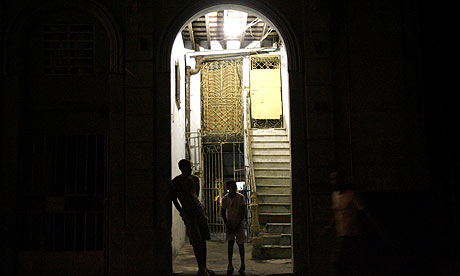
The opening five pages of Havana Red – the first of Leonardo Padura's acclaimed sequence of novels featuring Lieutenant Mario Conde – are a stunning example of what can be achieved in crime fiction. It's simple, atmospheric and a superb introduction to Padura's overwrought, erratic yet entertaining style.
It's dusk on a summer's evening in the Cuban capital. Conde is walking the streets of his old neighbourhood when he spots a bunch of kids playing baseball. He knows a few of them, some are children of Conde's old friends. Almost without thinking he asks if he can join them, and sees the looks on the kids' faces. The ball has barely been thrown when Conde makes his excuses and leaves. He realises as he walks away that the only reason the boys are playing at all is that there's money on the outcome. It sets the seal for the elegiac, corrupted and decaying tone of the rest of the novel.
Havana Red – or at least this translated version of it – is a far from subtle novel. The plot, concerning a murdered transvestite, is diverting without being wholly convincing. Conde is an acquired taste and nowhere does the writing match the power of that opening scene. Yet I was immediately compelled to move on to the next book in the series. And that was all because of Padura's depiction of Havana itself.
Padura writes beautifully about this broken, fractured city; a reddish brown realm of peeling stucco houses, heat-stunted trees and illegal drinking dens. Right from those first pages, Havana is fully formed as a character – more rounded, in fact, that many of the other slightly under-drawn denizens of the novel. Despite never having been to Cuba, I felt transported, utterly under its spell.
A sense of place is important in most novels, but in modern crime fiction, I believe, it's practically an imperative. It's something hinted at in the smog-soaked London of Holmes's cases, and in the country houses of Allingham and Christie, but only fully expressed in later writers; writers more interested in character and development than crafting simple whodunits.
In many ways it starts with the Los Angeles of Raymond Chandler, a stylised, sweaty sink of corruption and vice. His biographer, Frank McShane, wrote that Chandler used the detective story to "create the whole of Los Angeles in much the same way that Dickens and Balzac created London and Paris." It's something that has fired the imagination of crime writers ever since.
To me, the most effective of crime's fictional topographies are the ones that reveal something about the detective and something of the society in which they live. These are places that are at once a personal hell and a personal salvation.
One of the most impressive depictions of this dichotomy is to be found in Sjöwall and Wahlöö's 10 Martin Beck novels from the 1960s. Stockholm is glacially described, chill to the touch, and on the surface respectable. But even a cursory glance through the detective's eyes reveals a place of moral and spiritual collapse. Sjöwall and Wahlöö manage this without resorting to didacticism, the reader absorbing the sense of a society almost by osmosis. The Beck novels blazed a trail for some of our most important detectives – most notably Rebus and Wallander.
This vision of heaven and hell is not solely confined to city-dwelling cops. Even somewhere as genteel and as middle-class as Ruth Rendell's Kingsmarkham is blighted by horrors that the unflappable Chief Inspector Reg Wexford can scarcely fathom. It's interesting too, that Reg has barely changed over the years, but Kingsmarkham has changed immeasurably, Rendell using this shift to – rather clumsily – suggest that the whole country has gone, if not to the dogs, then well on the way to them.
Good crime writers simply describe a detective's stomping ground; great ones give it a pulse. And while Leonardo Padura may not be in the same league as Ian Rankin, Ruth Rendell, Val McDermid, Michael Connelly or James Lee Burke, he has created a wholly credible, sweat-soaked Havana. It's a place well worth a visit.

